Related Research Articles
Darwin most often refers to:

Darwin is the capital city of the Northern Territory, Australia. With a population of 139,902 at the 2021 census, the city contains most of the sparsely populated Northern Territory's residents. It is the smallest, wettest, and most northerly of the Australian capital cities and serves as the Top End's regional centre.

The Northern Territory is an Australian territory in the central and central northern regions of Australia. The Northern Territory shares its borders with Western Australia to the west, South Australia to the south, and Queensland to the east. To the north, the territory looks out to the Timor Sea, the Arafura Sea and the Gulf of Carpentaria, including Western New Guinea and other islands of the Indonesian archipelago.
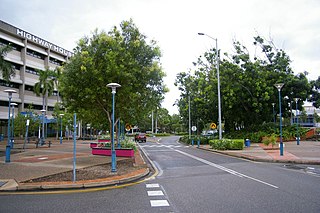
Palmerston is a planned satellite city of Darwin, the capital and largest city of Australia's Northern Territory. The city is situated approximately 20 kilometres from Darwin and 10 kilometres from Howard Springs and the surrounding rural areas. Palmerston had a population of 33,695 at the 2016 census, making it the second largest city in the Northern Territory.

Severe Tropical Cyclone Tracy was a small tropical cyclone that devastated the city of Darwin, in the Northern Territory of Australia, in December 1974. The small, developing, easterly storm was originally expected to pass clear of the city, but it would turn towards it early on 24 December. After 10:00 p.m. ACST, damage became severe, with wind gusts reaching 217 km/h (134.84 mph) before instruments failed. The anemometer in Darwin Airport control tower had its needle bent in half by the strength of the gusts.

Croker Island is an island in the Arafura Sea off the coast of the Northern Territory, Australia, 250 km (160 mi) northeast of Darwin. It was the site of the Croker Island Mission between 1940 and 1968.

RAAF Base Tindal is a Royal Australian Air Force (RAAF) military air base and civil aviation airfield located 8 nautical miles east southeast of the town of Katherine, Northern Territory in Australia. The base is currently home to No. 75 Squadron and a number of non-flying units, and also hosts the civilian Katherine Tindal Airport. First constructed in 1942, it was refurbished in the late 1960s as a bare base capable of being utilised when required. It was opened as a permanently manned RAAF base in 1989.
Keith John Austin Asche is a former Administrator of the Northern Territory of Australia and was the third Chief Justice of the Supreme Court of the Northern Territory.

No. 13 Squadron is a Royal Australian Air Force (RAAF) squadron. The unit saw combat during World War II as a bomber and maritime patrol squadron and is currently active as a mixed regular and reserve RAAF unit located in Darwin, fulfilling both operational support and training duties.
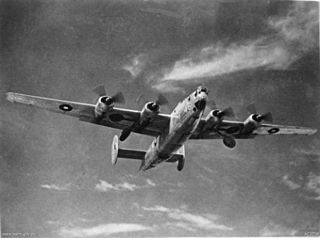
No. 99 Squadron was a Royal Australian Air Force (RAAF) heavy bomber squadron that was raised during World War II. Formed late in the war, the squadron ultimately did not see action as it became combat ready just as the war came to an end. After the war, it undertook general transportation duties before being disbanded in mid-1946.

Northern Territory Force was an Australian Army force responsible for protecting the Northern Territory during World War II. Most units assigned to the Northern Territory Force were based near Darwin and were responsible for defending the important naval and air bases in and around the town against a feared Japanese invasion. Northern Territory Force was renamed the 12th Division in late 1942 but this was short-lived. Australian Army units were rotated through northern Australia during the war and six infantry brigades served as part of Northern Territory Force between 1942 and 1945. The formation was reduced over the course of the war as the strategic situation in the Pacific turned in the Allies' favour, although remnants remained until the end of the war. In early 1946, it was converted back to the 7th Military District.
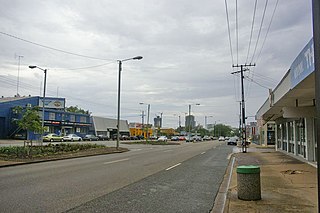
Stuart Park is an inner suburb of the city of Darwin, Northern Territory, Australia. It is the traditional country and waterways of the Larrakia people.
Men of Timor is a 1943 short documentary propaganda film about the guerrilla warfare activities of Sparrow Force on Timor Island during World War II.
Parap Airfield was the civilian aerodrome of Darwin, Northern Territory, in Australia between 1919 and 1946. Located in the coastal suburb of Parap, it was also known as Darwin Aerodrome and Ross Smith Aerodrome.
Hughes Airfield is an airfield in the Northern Territory of Australia located in the locality of Hughes. It was constructed during World War II for military use. The airfield now functions as a base for aerial firefighting aircraft to protect the outer rural suburbs of Darwin.
Lee Robinson was an Australian producer, director and screenwriter who was Australia's most prolific filmmaker of the 1950s and part of the creative team that produced the late 1960s international hit television series Skippy the Bush Kangaroo.
The Northern Territory Times was a newspaper in Darwin established in 1873 and closed in 1932. The paper was called the Northern Territory Times and Gazette from 1873–1927 and then TheNorthern Territory Times from 1927–1932. For a while, The North Australian (1883–1889), existed as a rival publication proposing "an independent voice".
The Northern Standard, also known by the uniform title Northern standard , was a newspaper published in Darwin, Northern Territory, Australia, from 1920 or 1921 to 1955. The paper was published by the North Australian Workers' Union from 1928 to 1955.
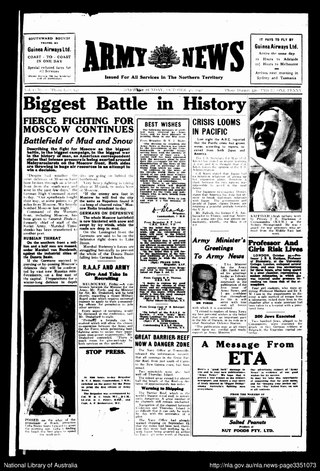
The Army News was a newspaper published in Darwin, Northern Territory, Australia during World War II between 1941 and 1946.
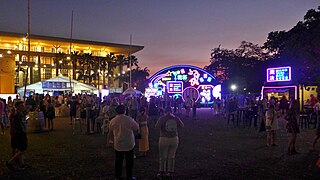
The Darwin Festival, founded as the Bougainvillea Festival in 1979 and named Festival of Darwin from 1996 to 2002, is an annual arts festival in Darwin, Northern Territory. It celebrates the multicultural aspects of the Northern Territory lifestyle. The festival is held over 18 days in August and comprises a series of events including outdoor concerts, workshops, theatre, dance music, comedy, cabaret, film and visual arts. The Darwin Aboriginal Art Fair is held under the umbrella of the festival, and the Garma Festival, NATSIAA art awards, and National Indigenous Music Awards are within the festival period.
References
- ↑ "PUTTING AUSTRALIA ON". The Northern Standard . Darwin, NT: National Library of Australia. 27 September 1946. p. 8. Retrieved 30 August 2015.
- ↑ "Continuum".